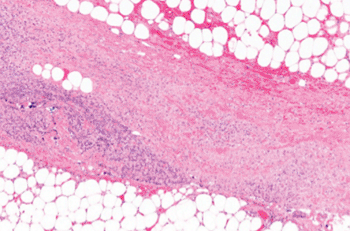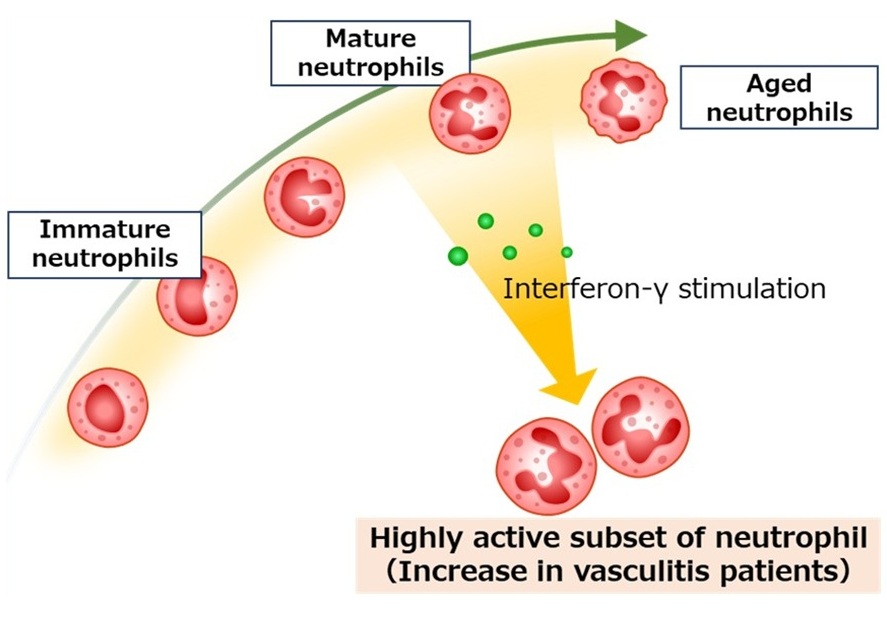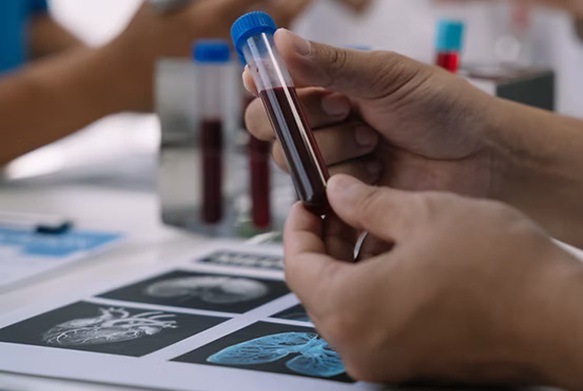Asparagine Metabolism Empowers Group A Streptococcus Infection
|
By LabMedica International staff writers Posted on 30 Jan 2014 |
![Image: Photomicrograph (900x) of Streptococcus pyogenes bacteria, viewed using Pappenheim\'s stain (Photo courtesy of the CDC - [US] Centers for Disease Control and Prevention). Image: Photomicrograph (900x) of Streptococcus pyogenes bacteria, viewed using Pappenheim\'s stain (Photo courtesy of the CDC - [US] Centers for Disease Control and Prevention).](https://globetechcdn.com/mobile_labmedica/images/stories/articles/article_images/2014-01-30/GMS-020a.gif)
Image: Photomicrograph (900x) of Streptococcus pyogenes bacteria, viewed using Pappenheim\'s stain (Photo courtesy of the CDC - [US] Centers for Disease Control and Prevention).

Image: Micrograph (H&E stain) of necrotizing fasciitis, showing necrosis (center of image) of the dense connective tissue, i.e., fascia, interposed between fat lobules (top-right and bottom-left of image) (Photo courtesy of Wikimedia Commons).
The bacteria that cause the frightening syndrome called "flesh-eating disease" have been found to be stimulated by the amino acid asparagine and inhibited by the chemotherapeutic enzyme asparaginase, which destroys asparagine.
Necrotizing fasciitis or NF, commonly known as "flesh-eating disease" is a rare infection of the deeper layers of skin and subcutaneous tissues, which quickly spreads across the fascial plane within the subcutaneous tissue. Individuals having compromised immune systems (due to conditions like diabetes, cancer, etc.) have greater risk of developing NF. It is a severe disease of sudden onset and is usually treated immediately with high doses of intravenous antibiotics. "Flesh-eating disease" is a misnomer, as the bacteria involved—most frequently Streptococcus pyogenes, or Group A Streptococcus (GAS)—do not actually "eat" the tissue. They cause the destruction of skin and muscle by releasing toxins, which include streptococcal pyogenic exotoxins.
Investigators at the Hebrew University of Jerusalem (Israel) reported in the January 16, 2014, issue of the journal Cell that during adherence to host cells, GAS releases streptolysin toxins, which create endoplasmic reticulum stress in the host cells. This stress causes an increase in the expression of the enzyme asparagine synthetase and the production of asparagine. The released asparagine is sensed by the bacteria, which induces altered expression of about 17% of the bacterial genes.
Asparaginase, a widely used chemotherapeutic agent, was found to block GAS growth in human blood and prevented GAS proliferation in a mouse model. To date asparaginase has not been used to treat GAS infections.
The Yissum Research Development Company (Jerusalem, Israel), the technology transfer arm of the Hebrew University of Jerusalem, has registered a patent for this discovery and is seeking commercial partners to help develop effective therapies against invasive Streptococcus infections.
Related Links:
Hebrew University of Jerusalem
Yissum Research Development Company
Necrotizing fasciitis or NF, commonly known as "flesh-eating disease" is a rare infection of the deeper layers of skin and subcutaneous tissues, which quickly spreads across the fascial plane within the subcutaneous tissue. Individuals having compromised immune systems (due to conditions like diabetes, cancer, etc.) have greater risk of developing NF. It is a severe disease of sudden onset and is usually treated immediately with high doses of intravenous antibiotics. "Flesh-eating disease" is a misnomer, as the bacteria involved—most frequently Streptococcus pyogenes, or Group A Streptococcus (GAS)—do not actually "eat" the tissue. They cause the destruction of skin and muscle by releasing toxins, which include streptococcal pyogenic exotoxins.
Investigators at the Hebrew University of Jerusalem (Israel) reported in the January 16, 2014, issue of the journal Cell that during adherence to host cells, GAS releases streptolysin toxins, which create endoplasmic reticulum stress in the host cells. This stress causes an increase in the expression of the enzyme asparagine synthetase and the production of asparagine. The released asparagine is sensed by the bacteria, which induces altered expression of about 17% of the bacterial genes.
Asparaginase, a widely used chemotherapeutic agent, was found to block GAS growth in human blood and prevented GAS proliferation in a mouse model. To date asparaginase has not been used to treat GAS infections.
The Yissum Research Development Company (Jerusalem, Israel), the technology transfer arm of the Hebrew University of Jerusalem, has registered a patent for this discovery and is seeking commercial partners to help develop effective therapies against invasive Streptococcus infections.
Related Links:
Hebrew University of Jerusalem
Yissum Research Development Company
Latest BioResearch News
- Genome Analysis Predicts Likelihood of Neurodisability in Oxygen-Deprived Newborns
- Gene Panel Predicts Disease Progession for Patients with B-cell Lymphoma
- New Method Simplifies Preparation of Tumor Genomic DNA Libraries
- New Tool Developed for Diagnosis of Chronic HBV Infection
- Panel of Genetic Loci Accurately Predicts Risk of Developing Gout
- Disrupted TGFB Signaling Linked to Increased Cancer-Related Bacteria
- Gene Fusion Protein Proposed as Prostate Cancer Biomarker
- NIV Test to Diagnose and Monitor Vascular Complications in Diabetes
- Semen Exosome MicroRNA Proves Biomarker for Prostate Cancer
- Genetic Loci Link Plasma Lipid Levels to CVD Risk
- Newly Identified Gene Network Aids in Early Diagnosis of Autism Spectrum Disorder
- Link Confirmed between Living in Poverty and Developing Diseases
- Genomic Study Identifies Kidney Disease Loci in Type I Diabetes Patients
- Liquid Biopsy More Effective for Analyzing Tumor Drug Resistance Mutations
- New Liquid Biopsy Assay Reveals Host-Pathogen Interactions
- Method Developed for Enriching Trophoblast Population in Samples
Channels
Clinical Chemistry
view channel
‘Brilliantly Luminous’ Nanoscale Chemical Tool to Improve Disease Detection
Thousands of commercially available glowing molecules known as fluorophores are commonly used in medical imaging, disease detection, biomarker tagging, and chemical analysis. They are also integral in... Read more
Low-Cost Portable Screening Test to Transform Kidney Disease Detection
Millions of individuals suffer from kidney disease, which often remains undiagnosed until it has reached a critical stage. This silent epidemic not only diminishes the quality of life for those affected... Read more
New Method Uses Pulsed Infrared Light to Find Cancer's 'Fingerprints' In Blood Plasma
Cancer diagnoses have traditionally relied on invasive or time-consuming procedures like tissue biopsies. Now, new research published in ACS Central Science introduces a method that utilizes pulsed infrared... Read moreMolecular Diagnostics
view channel
Simple Blood Test Better Predicts Heart Disease Risk
Cardiovascular diseases (CVDs) are the primary cause of death worldwide. A large proportion of these cases could be prevented by addressing lifestyle and environmental factors such as smoking, poor diet,... Read more
New Blood Test Detects 12 Common Cancers Before Symptoms Appear
Bowel cancer is the fourth most common cancer in the UK, with over 42,000 new diagnoses each year. Detecting bowel cancer in its early stages can be challenging, and as the disease progresses, survival... Read moreHematology
view channel
New Scoring System Predicts Risk of Developing Cancer from Common Blood Disorder
Clonal cytopenia of undetermined significance (CCUS) is a blood disorder commonly found in older adults, characterized by mutations in blood cells and a low blood count, but without any obvious cause or... Read more
Non-Invasive Prenatal Test for Fetal RhD Status Demonstrates 100% Accuracy
In the United States, approximately 15% of pregnant individuals are RhD-negative. However, in about 40% of these cases, the fetus is also RhD-negative, making the administration of RhoGAM unnecessary.... Read moreImmunology
view channel
Stem Cell Test Predicts Treatment Outcome for Patients with Platinum-Resistant Ovarian Cancer
Epithelial ovarian cancer frequently responds to chemotherapy initially, but eventually, the tumor develops resistance to the therapy, leading to regrowth. This resistance is partially due to the activation... Read more
Machine Learning-Enabled Blood Test Predicts Immunotherapy Response in Lymphoma Patients
Chimeric antigen receptor (CAR) T-cell therapy has emerged as one of the most promising recent developments in the treatment of blood cancers. However, over half of non-Hodgkin lymphoma (NHL) patients... Read moreMicrobiology
view channel
Handheld Device Delivers Low-Cost TB Results in Less Than One Hour
Tuberculosis (TB) remains the deadliest infectious disease globally, affecting an estimated 10 million people annually. In 2021, about 4.2 million TB cases went undiagnosed or unreported, mainly due to... Read more
New AI-Based Method Improves Diagnosis of Drug-Resistant Infections
Drug-resistant infections, particularly those caused by deadly bacteria like tuberculosis and staphylococcus, are rapidly emerging as a global health emergency. These infections are more difficult to treat,... Read more
Breakthrough Diagnostic Technology Identifies Bacterial Infections with Almost 100% Accuracy within Three Hours
Rapid and precise identification of pathogenic microbes in patient samples is essential for the effective treatment of acute infectious diseases, such as sepsis. The fluorescence in situ hybridization... Read morePathology
view channel
Sensitive and Specific DUB Enzyme Assay Kits Require Minimal Setup Without Substrate Preparation
Ubiquitination and deubiquitination are two important physiological processes in the ubiquitin-proteasome system, responsible for protein degradation in cells. Deubiquitinating (DUB) enzymes contain around... Read more
World’s First AI Model for Thyroid Cancer Diagnosis Achieves Over 90% Accuracy
Thyroid cancer is one of the most common cancers worldwide, and its precise management typically relies on two primary systems: (1) the 8th edition of the American Joint Committee on Cancer (AJCC) or ... Read more
Breakthrough Diagnostic Approach to Significantly Improve TB Detection
Tuberculosis (TB) remains the deadliest infectious disease globally, with 10.8 million new cases and 1.25 million deaths reported in 2023. Early detection through effective screening is crucial in identifying... Read more
Rapid, Ultra-Sensitive, PCR-Free Detection Method Makes Genetic Analysis More Accessible
Genetic testing has been an important method for detecting infectious diseases, diagnosing early-stage cancer, ensuring food safety, and analyzing environmental DNA. For a long time, polymerase chain reaction... Read moreTechnology
view channel
Disposable Microchip Technology Could Selectively Detect HIV in Whole Blood Samples
As of the end of 2023, approximately 40 million people globally were living with HIV, and around 630,000 individuals died from AIDS-related illnesses that same year. Despite a substantial decline in deaths... Read more
Pain-On-A-Chip Microfluidic Device Determines Types of Chronic Pain from Blood Samples
Chronic pain is a widespread condition that remains difficult to manage, and existing clinical methods for its treatment rely largely on self-reporting, which can be subjective and especially problematic... Read more
Innovative, Label-Free Ratiometric Fluorosensor Enables More Sensitive Viral RNA Detection
Viruses present a major global health risk, as demonstrated by recent pandemics, making early detection and identification essential for preventing new outbreaks. While traditional detection methods are... Read moreIndustry
view channel
Cepheid and Oxford Nanopore Technologies Partner on Advancing Automated Sequencing-Based Solutions
Cepheid (Sunnyvale, CA, USA), a leading molecular diagnostics company, and Oxford Nanopore Technologies (Oxford, UK), the company behind a new generation of sequencing-based molecular analysis technologies,... Read more
Grifols and Tecan’s IBL Collaborate on Advanced Biomarker Panels
Grifols (Barcelona, Spain), one of the world’s leading producers of plasma-derived medicines and innovative diagnostic solutions, is expanding its offer in clinical diagnostics through a strategic partnership... Read more









 Assay.jpg)











